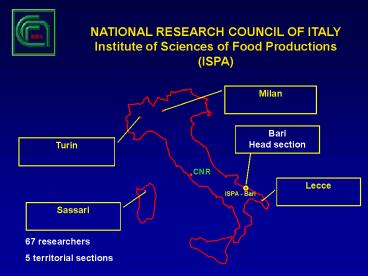Diapositiva 1 - PowerPoint PPT Presentation
1 / 8
Title:
Diapositiva 1
Description:
Identification of critical points in agri-food productions aimed at prevention ... moulds responsible of food spoilage and contaminating agriculture commodities, ... – PowerPoint PPT presentation
Number of Views:39
Avg rating:3.0/5.0
Title: Diapositiva 1
1
NATIONAL RESEARCH COUNCIL OF ITALY Institute of
Sciences of Food Productions (ISPA)
67 researchers 5 territorial sections
2
MISSION
- Production of food with improved nutritional
characteristics - Development of novel processes and technologies
for agri-food production - Identification of critical points in agri-food
productions aimed at prevention or elimination of
toxic contaminants
3
FIELDS WHERE A PROFITABLE AS-EU CO-OPERATION CAN
BE DEVELOPED
- Environmental friendly technologies for
production of safier food (biological and
integrated control) - Detection and analysis of toxic food contaminants
(mycotoxins) - Novel technologies for production of high-quality
horticulture products
4
BIOLOGICAL CONTROL
Control of plant diseases, pests and weeds by
means of beneficial micro-organisms
- Reduce the environmental pollution due to the use
of chemicals in agriculture (alternative to
methyl bromyde fumigant that must be phased out
according to Montreal Protocol, 1992) - Reduce health risks associated with pesticide
residues in food chain - Reduce risk of development of resistance to
pesticides in plant pathogens and pests - Useful in organic farming
- Possible spin-off and interest of SMEs
5
Commercial Trichoderma-based products registered
for use against plant diseases
6
MYCOTOXINS
Toxic metabolites produced by moulds responsible
of food spoilage and contaminating agriculture
commodities, food- and feedstuffs (cereal grains,
oily seeds, nuts)
Hemorrages in muscle, fat (left) and mouth
(below) of farm and experiment animals
Dermatoxicity of T-2
T-2 toxicosis in a chicken. Ulcerative beak
lesions
7
MYCOTOXINS NECESSARY JOINT EFFORTS
- Harmonisation of regulaments and tolerance levels
of mycotoxins in agriculture commodities for
inport-export - Standardisation and validation of the methods of
sampling and analysis
8
NOVEL TECHNOLOGIES FOR PRODUCTION OF HIGH-QUALITY
HORTICULTURE PRODUCTS
The entry of many Asian countries into the WTO
has opened up new market opportunities for them,
but also exposed them to greater competition.
Moreover, on the world markets there is a demand
by consumers for products perceived to be of
higher quality than some those being grown and
sold in the region at present
Objectives
- To improve growing systems and cultural
practices - To improve post-harvest practices to minimise
losses of valuable substances during transport
and storage































